To commemorate five years of MAD MAX: FURY ROAD, released on this day in 2015, ordained an instant classic upon release and only grown in estimation ever since, Daily Grindhouse got the old gang together — and brought in some new friends — to talk about our favorite depictions of the post-apocalypse in animation, TV, film, comic books, music, and literature, and anywhere else in popular culture.
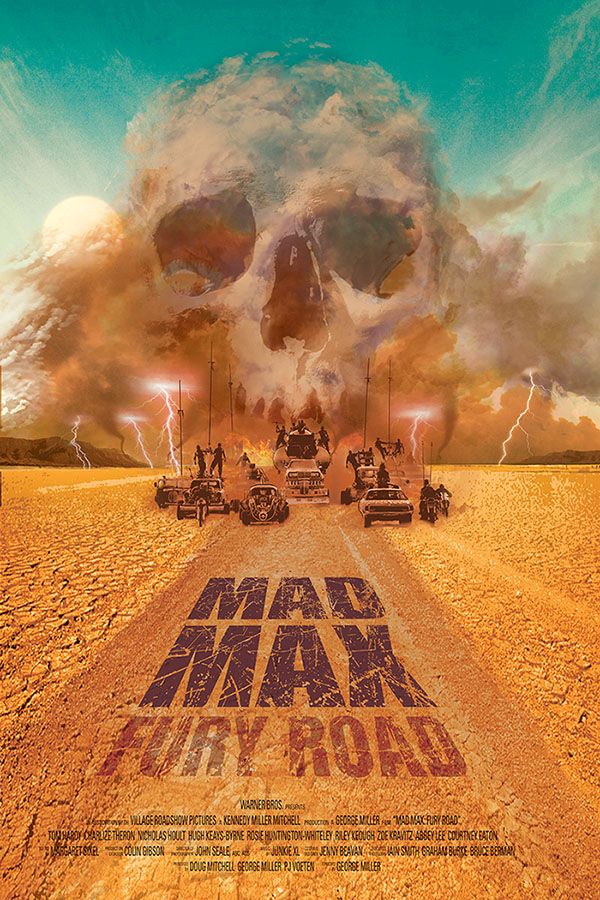
These are ours. What are yours? The comment section, now and surely even after civilized society is gone, is open.
What is your favorite piece of Post-Apocalyptic Entertainment?

Mary Beth McAndrews — FIRE FORCE (2019-present)
Anime has a knack for tackling and analyzing the post apocalyptic landscape, whether it is full of weaponized mechs or barren deserts. But perhaps on of my favorite looks at the post apocalypse is Fire Force, an anime series about a world born from the ashes after it has been completely burned down.
Human combustion is a normal part of life in this version of the world. People turn infernal, meaning they spontaneously combust and are transformed into some kind of demon. The Fire Force, a holy group of future firefighters, are humanities only defense against these creatures. They themselves are mostly pyrokinetics, able to manipulate and weaponize fire to protect humanity. But the focus on Fire Force is on Company 8, the underdogs who only want to save the world and solve the mystery of human combustion.
This ragtag group of pyrokinetics and do-gooders are the emotional core to the show. This group of misfits come together as a family that has their moments of strife but ultimately live and love each other in the face of a world full of demons. But it’s not the relationships that make Fire Force compelling. It is the complex and fascinating world that is 250 years after the world was swallowed in fire.
From new religions, new energy sources, and new empires, this is a fully-realized world that is easy to get lost in. Plus, the stunning animated fight sequences will leave your eyes wide with glee. It is a post-post apocalypse, a world rebuilt after humanity’s destruction, but still poised on the brink of disaster.

Rob Dean – the “Rapture’s Delight” episode of American Dad (2009)
As many have noted here and amongst ourselves, this was a difficult choice to make—there are so many great stories born from civilization’s end, plus the added fun twist of how people think the end will come about. While I love me some Italian knockoffs, and TURBO KID is fantastic…my answer has to be “Rapture’s Delight.” The ninth episode of the fifth season of American Dad, “Rapture’s Delight” is a great tale in three-acts: pre-apocalypse, mid-apocalypse, and post-apocalypse. Oh and it’s a Christmas episode!
The Smith family is attending Christmas service at the church when the Rapture happens — but stalwart Christian conservative Stan and his wife, Francine, are left behind. For those unfamiliar with the biblical idea of the rapture, here’s a hilarious rundown from the episode:
Eventually Jesus does return — and Francine leaves Stan for the Son of God once Stan proves he’s selfishly more interested in his own salvation than caring about his wife. The next act is a fantastic phantasmagoria of post-apocalyptic riffs with run-down cities, wastelands, demons, biker gangs, ESCAPE FROM NEW YORK synth score, Stan’s MAD MAX BEYOND THUNDERDOME-like gray streak in his hair, shotgun violence, “Freya” by The Sword, and a Christmas miracle.
American Dad was always in Family Guy’s shadow (and often dismissed because of that), but the show was able to evolve into a brilliant bit of absurdity with audacious plots. Its Christmas episodes are some of the best ever, and “Rapture’s Delight” is incredible. By blending humor, action, horror, religion, and more — it’s the best of all ends of the world.
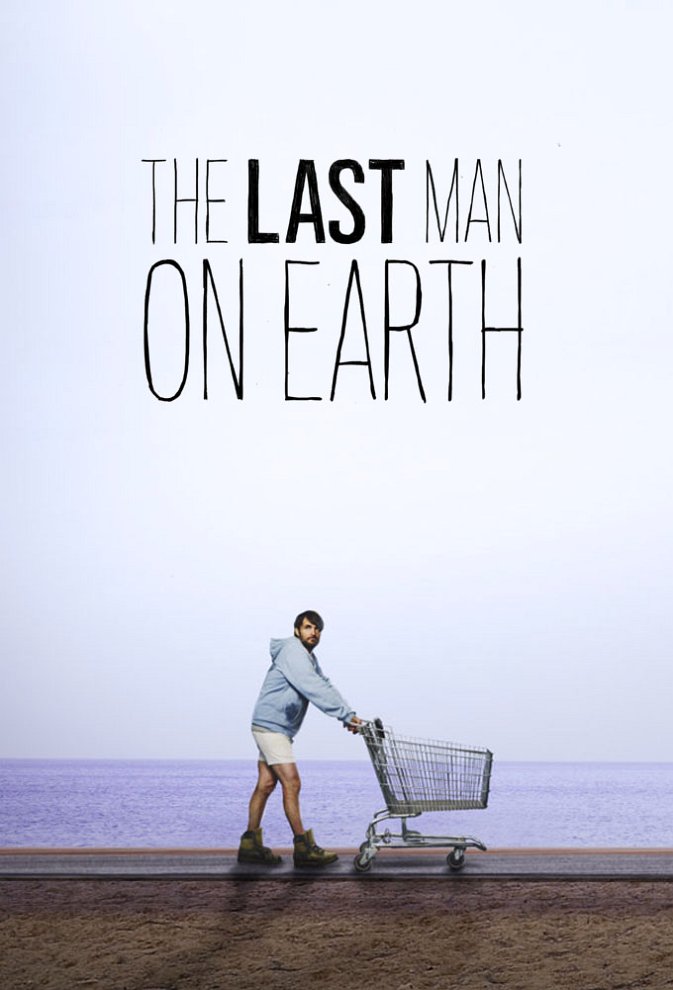
P. Scott Russell — The Last Man On Earth (2015-2018)
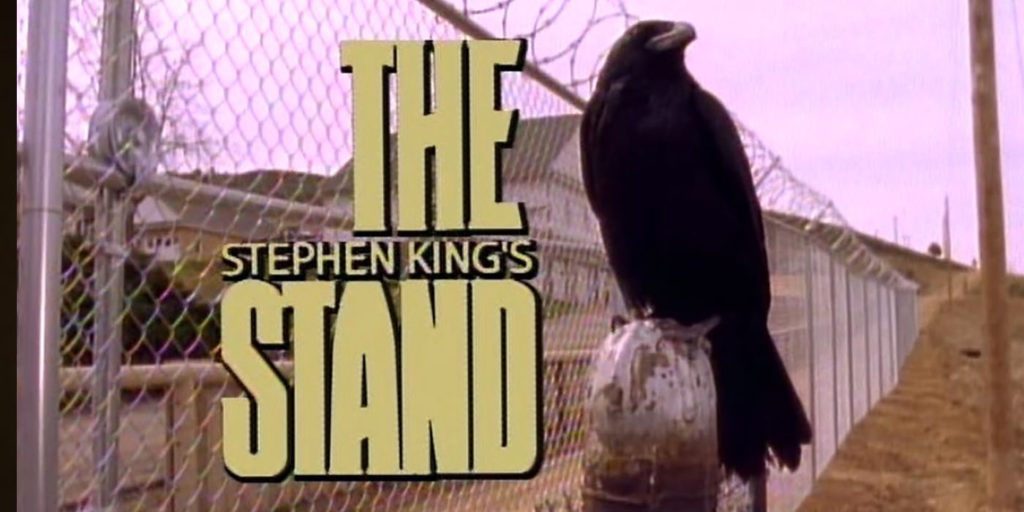
Aundria Parker — THE STAND (1994)
The Stand is Stephen King’s big, bouncing baby of a novel, the hardcover weighing in somewhere around a slight newborn. At 1100+ pages, it sprawls through the breakout of a deadly virus called Captain Tripps, the decimation of life as we know it, and the fates of dozens of characters. While the original cover art makes it look like fantasy — two figures; one dark, one light, each with a blade and both…wearing tights? — the reality of The Stand feels too on the nose given our current situation.
In May of 1994, ABC aired the four-part miniseries adaptation of King’s novel, directed by Mick Garris with the teleplay written by King himself. The leaking of the virus and the widespread death are mostly contained to the first part of the miniseries, The Plague. Sickness and quarantine, paranoia and panic. Hey, we know that tune. Baby, can you dig your man? When the death toll starts to rise, and the truth of humanity’s fate becomes clear, there’s rioting, martial law, and the execution of the press, on air. For starters. The extremes presented at the beginning of the end seemed outlandish in 1994. Now, at our current pace, it kinda feels like…2024?
But Captain Tripps, workhorse of a plague that it is, completes its mission. The airwaves fall silent, the tanks still, and the last of the naysayers and doomsdayers go stiff. There’s a whole lot to THE STAND that isn’t about the virus, of course. It comes down to good and evil, the best of what’s within us and the worst. You can welcome your damnation without knowing it.
I love this movie, and I don’t care that it looks dated or feels a little Velveeta. I’ve seen it so many times, and I still feel the sting when certain characters meet their unfair fates. I love the twangy score, dusty like the cornfields of Nebraska and the deserts of Nevada. I’ve never seen a more effective use of Don’t Fear The Reaper. I love that there’s a murderers row of talent involved, including horror royalty. Sherman Howard plays a baddie in a lab coat, an authority figure gone crackers. Ed Harris, Matt Frewer, and Corin Nemec all have sizeable roles. There’s a cameo by the authorman himself, as well as Kathy Bates, Warren Frost, Tom Holland, Sam Raimi, John Landis, and Joe Bob Briggs. I love all of it, but especially the chicken-fried, clammy-skinned, wide-eyed terror of The Plague.
The movie opens with the final stanza of T.S. Eliot’s “The Hollow Men:”
This is the way the world ends
This is the way the world ends
This is the way the world ends
Not with a bang but a whimper.
There’s a new version of THE STAND in production for CBS All Access, a ten-parter with a finish date TBD.
Let’s hope it airs before the last whimper.

Honorable mention: Xavier Gens’ THE DIVIDE (2011). Nothing like a nuclear blast to bring out the nasty.
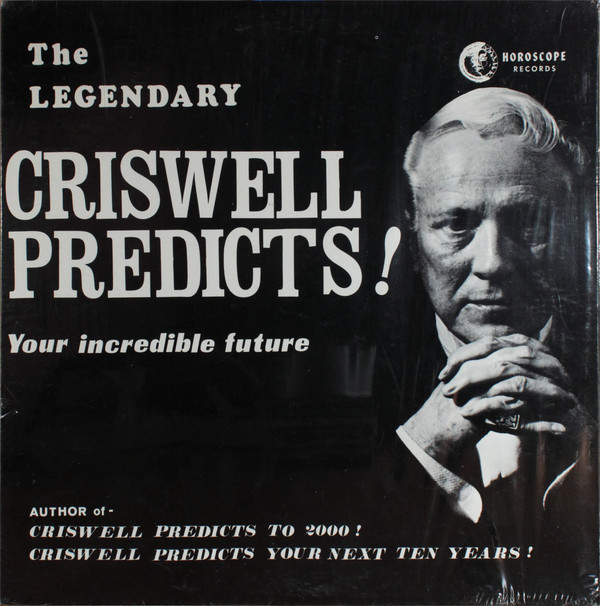
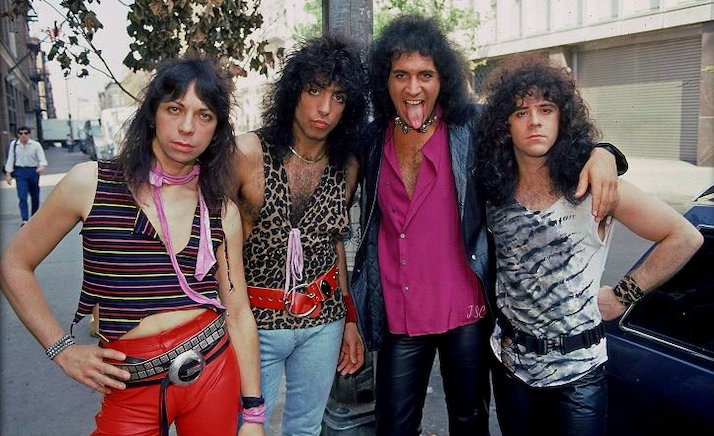
Rich Love — the “Lick It Up” music video by KISS (1983)
Like everyone, I love a good post-apocalyptic story/movie. Fuck, my dad brought me to see THE ROAD WARRIOR in the theater when I was 11 and it was the one of greatest days of my life up to that one point. But I guess I never realized how much I wanted to see a post-apocalyptic world where the fire was plenty, the music ruled, and that was almost exclusively populated by hot cyberpunk females of all races and KISS until the “Lick It Up” video came out. This song was KISS’s first single after taking their makeup off, and they needed a cool video to relaunch the new KISS. ‘80s metal dudes loved MAD MAX and I’m sure that was a big part of the reason why KISS wanted their big reveal video to be shot like this.
It’s a nice change of pace for one of these “the world is burned out and ruined” stories. Usually, there’s some horrible war going on and people are killing their children for fuel or something along those lines. In the “Lick It Up” version of the apocalypse, everyone’s nice and having a good time, the hot babes are having some sort of celebratory meal and sharing some sort of liquid from a futuristic orange petrol canister with KISS (though, noticeably, only the original members Gene Simmons and Paul Stanley and not the replacement guys) . Sure, KISS were cooler with the make-up on and this is really just a neighborhood in the South Bronx that had decayed to the point that it looked like a neutron bomb had been dropped. But it did more than enough to set the vibe, and offset how crazy awkward Gene Simmons was without his make-up on.
It’s a music video, and it helps that I think this song rules. I’ve said it before and I’ll say it again, if you’re writing a rock and roll song about, well what most rock and roll songs are about, there’s no better first line to a song then “I don’t want to wait till you know me better.” No, it’s not “Love Gun” but this video definitely helped get grammar school-me back into KISS.
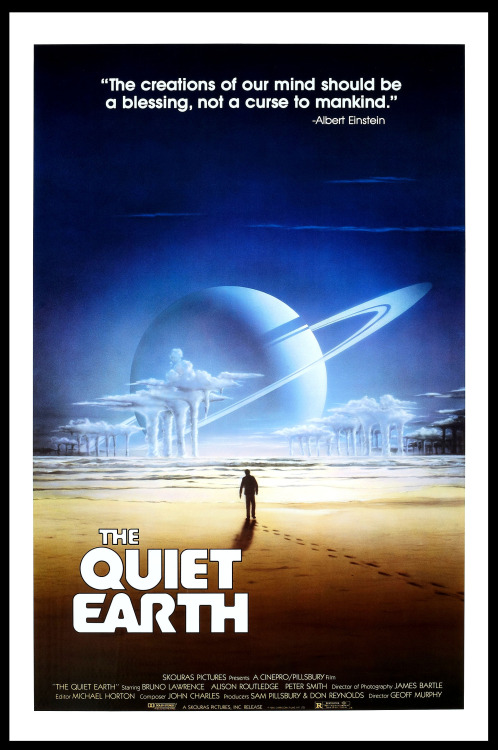
Craig Edwards — THE QUIET EARTH (1985)
I can’t say 100% that it’s my favorite, but because it’s an unsung gem, I want to throw the spotlight on this Australian science fiction movie. Taken from a novel by Craig Harrison, the screenplay is by Sam Pillsbury, Bill Baer, and lead actor Bruno Lawrence and the movie is directed by Geoff Murphy (FREEJACK). Bruno Lawrence wakes up one morning to an unpopulated world. Everyone is simply…gone. Lawrence goes through the usual “guy alone in the world” stuff — confusion over what happened; then the glee of freedom to take and do whatever you want; then loneliness; then the need to find anyone or solve the mystery.
What he finds when he goes on his quest is pretty good; and although the eventual explanation almost necessarily underwhelms thanks to the viewer’s imagination running wild in the early reels (much the same as it was for me in HAPPY DEATH DAY 2U) it’s still a very well-mounted science fiction movie on what must have been a somewhat limited budget. It’s not a whiz bang flick chock full of special and visual effects; but what effects there are come off charming and old school. Lawrence was a seemingly ubiquitous presence in Australian/New Zealand movies in the ’80s; and gives a very likable performance here. There’s not much else I can say about the movie without dropping into spoiler territory, so I’ll simply say the movie is available on Blu-Ray and is also a cheap rental on Amazon Prime — check it out!

Gena Radcliffe — HARDWARE (1990)

Mike Vanderbilt – DEATH RACE 2000 (1975)
Even with its comic book palate and what amount to pro-wrestling personalities driving life-size Hot Wheels, Paul Bartel’s DEATH RACE 2000 arguably best resembles what a post-apocalyptic America would look like. The country wouldn’t immediately devolve into a wasteland overrun by mutant punks killing one another in the streets over oil: America would find a way to monetize and televise the body count first.
There is no subtlety in the satirical script by longtime Roger Corman collaborators Charles B. Griffith and Robert Thom about a cross-country race that combines Le Mans, Sunday football, WWF, and… let’s call it a form of population control. Being a Corman production, the film delivers top-notch violence, T & A, and a pitch black, violent sense of humor. In a decades-long run, DEATH RACE 2000 remains a quintessential Corman production, delivering thrills, spills, and quality kills executed with style by Corman favorites David Carradine, Sylvester Stallone, Mary Woronov, Roberta Collins, and noted Los Angles DJ “The Real Don Steele” stealing scenes as the race announcer.

Jeremy Lowe — TURBO KID (2015)
When the trailer for TURBO KID hit YouTube, I was instantly in awe of everything that it is. I love a great homage, and this is probably one of the best tributes to 1980s post-apocalyptic action films I have ever seen. Writers/directors François Simard, Anouk Whissell, and Yoann-Karl Whissell created a story that perfectly encapsulated the whimsy of fantasy films. It brought to mind director Alan Johnson’s SOLARBABIES (1986), but still brutal enough to make me think of the kill-or-be-killed world of filmmaker Enzo G. Castellari’s 1990: BRONX WARRIORS (1982).
In August of 2015, the Chicago Filmmakers association had a screening of TURBO KID, and I couldn’t pass up seeing this film with an audience. I brought a group of friends with me who didn’t know much about the film, which personally I think is the best way to go into seeing a movie. Cinematographer Jean-Philippe Bernier did such a perfect job of capturing the aesthetic of the 1980s post-apocalyptic films that some of my friends were asking how they could have missed this film when it was originally released. I kind of giggled when I explained that this was a brand-new film that they just saw.
I absolutely loved the relationship between The Kid (Munro Chambers) and Apple (Laurence Leboeuf) . It seems so genuine, and to see it blossom in the wasteland of 1997 was spot on. Then to see these two child-like superheroes do battle against the tyrannical overlord Zeus (Michael Ironside) just made this movie magical. This movie has a real heart. As a child in the 1980s, who grew up on all the films that influenced TURBO KID, these characters’ story arcs really touched something in my soul.
Between the over-the-top blood and gore, the tongue-in-cheek humor, and the true love of post-apocalyptic cinema, TURBO KID is a must-see. In a world where there isn’t much to be joyful over right now, we film fans need to be able to enjoy a little cotton candy for the brain. TURBO KID finely balances its respect for the past without being complete nostalgia porn.

Paul Freitag-Fey — NEON CITY (1991)
I wouldn’t know what to choose if the question had been “What’s the best piece of post-apocalyptic entertainment?” because there are so many great ones — MAD MAX: FURY ROAD, THREADS, I Am Legend, Alas Babylon, Z for Zachariah — that would be up for consideration. How the heck can you compare a serious treatment of what the ramifications of a nuclear war would be with a glorious crowdpleaser?
Thankfully, that wasn’t the question. “Favorite” post-apocalyptic entertainment is easy, because at least once a year, I go back to Monte Markham’s 1991 direct-to-video film NEON CITY.
NEON CITY stars Michael Ironside as a bounty hunter transporting a fugitive (Vanity) across a typical apocalyptic wasteland to the titular city with a group of assorted folks played by the likes of Lyle Alzado, Juliet Landau, WKRP in Cincinnati’s Richard Sanders and soap star Valerie Wildman. Like many of the films of the era, NEON CITY is essentially just a repurposed Western (the STAGECOACH to, say, WILD GONE WILD’s THE MAGNIFICENT SEVEN or OMEGA DOOM’s A FISTFUL OF DOLLARS) with some sandy locales.
However, thanks to a fine cast and a willingness to be genuinely dark, NEON CITY rises above most of its direct-to-video brethren. One sequence in particular is more THREADS than MAD MAX, as the caravan encounters a family dying of mutation desperate to just get water for their child. Topped off by a fairly bleak conclusion, NEON CITY takes the STAGECOACH formula and does the best it can with it, thanks to a script by Ann Lewis Hamilton, a television writer writing under a pseudonym who has yet to script another feature.
NEON CITY doesn’t break any real ground in furthering the world of post-apocalypse films, but it aired on cable often enough that it feels like a familiar, comfortable, and appropriately bleak adventure in the genre. The best? Far from it, but it’s sure as hell my favorite.
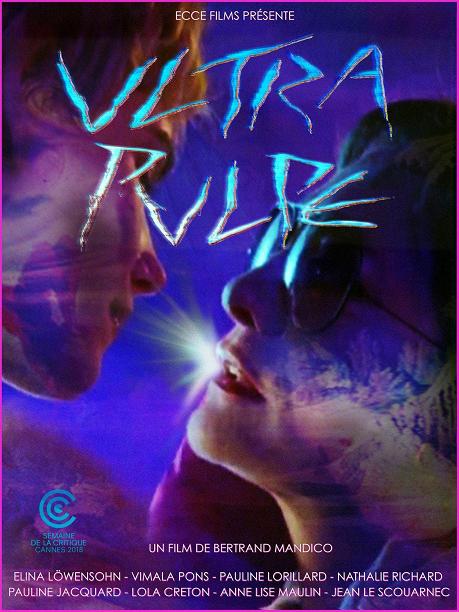
Lisa Dreyer — ULTRA PULPE (2018)
ULTRA PULPE, Bertrand Mandico’s short film from 2018, is the bizarrely imaginative, sexy and exquisitely art-directed version of a life after the apocalypse we can only hope to aspire to. The ending of a torrid love affair between a director and actress on set mirrors the ending of the world, a deserted, neon planet straight out of a B-movie, sound-tracked by pounding techno. Mandico’s apocalypse might look like an other-wordly fashion shoot, but the tension is high and emotions are on overdrive as the crew, wielding lumpy, grotesque camera equipment, attempt to finish a film despite the difficult circumstances. Bizarre aliens, dangerous monsters, and a hellish landscape filled with peril are no match for the drive to create. We’re never certain where the film set ends and real life begins, as the director and actress (played to perfection by Elina Löwensohn and Pauline Jacquard), slide from one scene to the next, their world transforming from sci-fi dystopia to a giallo-esque horror set, to a grotesque erotic film. Trapped in our dull homes, such worlds, despite the dangers lurking, have a new, distinct appeal.
Our current version of the apocalypse is sad and pale by comparison. Mandico’s apocalyptic afterworld is marked by sex, skintight space-age clothing, and a lust for life despite the odds. Ours is a slow descent into sloppiness and despair, people in grey sweats, staring at screens, alone. If the world has to end, please let it be directed by Mandico, complete with good lighting and a pulsing soundtrack.
Mandico’s newest feature, AFTER BLUE, was set to premiere at Cannes this year, which of course, in a bizarre turn of events even the most creative minds couldn’t have predicted, has been moved online. However, ULTRA PULPE, whose English title is fittingly APOCALYPSE AFTER, gives us hope that filmmaking and creativity will prevail, despite the overwhelming circumstances.
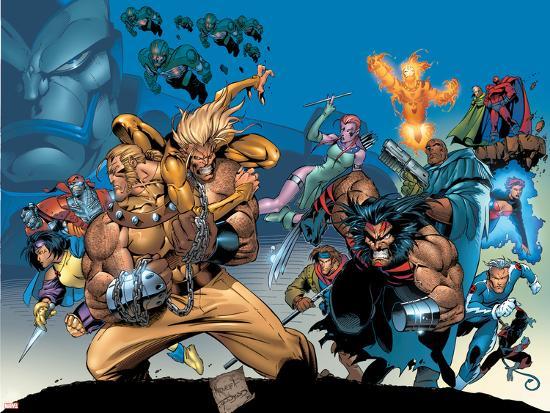
Brett Gallman — X-MEN: AGE OF APOCALYPSE (1995)
The ’90s comics landscape was dominated by universe-shattering events, most of them orchestrated to grab headlines and media exposure. Once DC killed off Superman and scored tons of publicity, the genie was out of the bottle, granting demented fanboy wishes of validating the medium. It quickly turned into a monkey’s paw situation, though, as Superman’s death is now largely remembered as a publicity stunt that skewed the course of an entire decade that saw increasingly ludicrous storylines. Batman’s back was broken (he got better); Spider-Man turned out to be a clone (at last check, he got this straightened out); most of the Marvel Universe’s heavy-hitters were exiled to a pocket universe (they made it back).
But there’s one that really captured my attention: like all of the cool ’90s kids, I was obsessed with the X-Men, and there was no way Marvel was going to let its band of mutants sit out the decade’s major event/crossover hysteria. They committed to the bit, too: not content to simply kill off a major character, Marvel offed Professor Xavier in the past, setting off a chain of events that rewrote X-history. Without Xavier around, his longtime rival, friend, and bitter enemy Magneto took up the mantle of the X-Men but did so amidst the apocalyptic ruins of the Marvel Universe.
AGE OF APOCALYPSE imagines a world where En Sabah Nur — the world’s first mutant — reigns supreme having eradicated most of humankind, and it had the perfect amount of nonsense to light my easily impressed 12-year-old mind on fire. For several months, the X-books were rebranded with entirely different titles and characters, many familiar but reimagined. Now missing a hand, Wolverine Weapon X carries out missions on behalf of the world’s few surviving humans. Cyclops patrols concentration camps at the behest of Mr. Sinister. Once one of Apocalypse’s loyal soldiers, Sabretooth has joined forces with the X-Men. Dogs and cats, living together, mass hysteria. As a kid who adored WHAT IF?, I couldn’t help but love that Marvel did an months-long alternate universe event. And even though I casually observe comics now, my ears still perk up whenever Marvel revisits AGE OF APOCALYPSE. Who knows — maybe someday we might even see Marvel Studios take a stab at a live-action version very far down the road. I mean, it’s not like anyone has tried to bring Apocalypse to the big screen yet — right?

Albert Muller — STEPHEN KING’S THE STAND (book: 1978; miniseries: 1994)
For the last 30-odd years, I’d have had to go with this one. For a post-apocalyptic story, it was always the one that had the characters I loved (and hated, and even pitied) the most. Almost all of us wanted to be Stu but were at best Larry, aside from those poor souls who had a bit too much Harold in their DNA. It’s as funny as the end of the world could possibly be, a little wise, and sometimes achingly sad. It’s also hugely exciting and scary as hell, thanks to not just the Walkin’ Dude but also the chilling plausibility of the whole thing.
Which, obviously, is why it’s weird now. You think “this could totally happen” and then something a bit like it does happen, and it sucks about as badly or worse than you imagined.
I mean, things are not as bad as they are in this book or the ’90s miniseries. But sometimes they feel just that bad.
The surreality of it all has teeth, as Big Steve might put it — and yes, they do bite somewhat.

Jon Abrams — I AM LEGEND by Richard Matheson (1954)
There have been a handful of film adaptations of this story. LAST MAN ON EARTH (1964) has its eerie moments, as obviously must do Vincent Price amidst an all-Italian cast. THE OMEGA MAN (1971), my own initial entryway into the story, is the campiest. Charlton Heston in a peaked cap will do that. The Will Smith version is serviceable but even upon release in 2007, it strained under the weight of too much CGI. And I just found out about The Asylum’s counterpoint, I AM OMEGA (2007), with Mark Dacascos, which now I am on a mission to find. Really, NIGHT OF THE LIVING DEAD (1968) is the truest cinematic “adaptation” to date. George A. Romero really only used Matheson’s story as a jumping-off point, and obviously went a different way, but the idea of the undead surging and swarming a fragile domicile, if it started with Matheson, has never been captured better than in Romero’s 1968 masterpiece.
But go back to the book. Always. It’s like a bible to me. Recently, Tor Books put out a beautiful and affordable pocket-sized hardcover edition, with the thinnest of pages — it couldn’t feel more like a bible. And how fitting.
I AM LEGEND is eternal. It has never felt dated, not after six-and-a-half decades. To me it’s as durable an American novel as MOBY DICK, or if it’s to be classified as a novella, let’s say THE LEGEND OF SLEEPY HOLLOW. These are essential, vital works of fiction, which gain new meaning with each decade of history, with each new gain and with each fresh Hell.
As I write this, we are all living in quarantine. Those of us with sense, anyway. There are some out in the streets, protesting for their right to be exposed to, contract, and spread a potentially fatal virus for which there is currently no vaccine. If America in 2020 were I AM LEGEND, about a man barricading himself inside a self-made fortress meant to keep out a vampiric horde calling for his doom, it’s fairly clear who would be who. (The brilliance of I AM LEGEND, by the way, is that by its ending and in its very title, it challenges the reader’s perception of who’re the good guys and who’re the bad guys.)
To me, this story isn’t about the horde. It’s about the man. The staying power of this story is that it’s an inside job. It’s about the isolation. A fair critique of the novel, and of my own writings, as paltry as they are in comparison, is the emphasis on man. In I AM LEGEND, Robert Neville spends more time than you may even remember being tormented by his lust, beckoned every night by undead temptresses but knowing that succumbing to these urges would mean death. I don’t think Matheson meant to exclude the female perspective; he chose to tell this story about this particular man. Maybe there’s a female author out there dreaming up her own tale of the last woman on earth. I’d love to read that!
But what I respond to above all about I AM LEGEND is the drudgery of loneliness. The drudgery, and the comforts. If you are alone, nobody can hurt you. In the words of another character from another great statement about solitude, “I am alone. I am not lonely.” I have always been an isolator. Even surrounded by loved ones, I’ve historically found a way to be apart, if not physically then figuratively. I’m never more alone than in a crowd. Walking through midtown Manhattan at noon (in the time before quarantine), I could still manage to feel like the last man on earth. This is what depression is like, maybe. Is that an illustration that makes sense to fellow depressives? I wouldn’t know. I never ask anybody. What I AM LEGEND captures better (for me) than any piece of art I’ve ever seen or read or heard is what it’s like.
We are in the post-apocalypse, right now. Some of us are going stir-crazy. Some of us are turning to liquor, like Robert Neville did. Some of us are picking up our metaphorical pitchforks and going on the march. God help them. Some are turning to God, by the way! And me, I’m weirdly placid. Surely, I’ve found ways to isolate even in isolation, and I’ve had many dark moments over the past several weeks, but no more than usual — if anything, less. The truth is: I can take it. I’ve had the practice. That doesn’t make me a tough guy. It makes me a master isolator. I wouldn’t wish it upon you. But that’s who I am. And I see it reflected every time I reread this wonderful, terrifying, perfect book.
- [THE BIG QUESTION] WHAT’S YOUR FAVORITE FEMALE ENSEMBLE IN MOVIES? - July 22, 2016
- [IN THEATERS NOW] THE BOY (2016) - January 24, 2016
- Cult Movie Mania Releases Lucio Fulci Limited Edition VHS Sets - January 5, 2016
Tags: The Post-Apocalypse


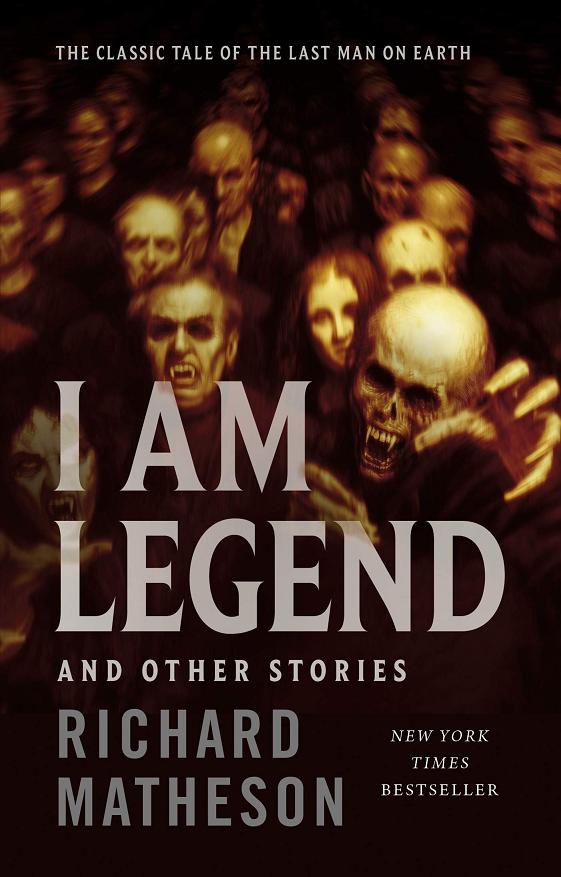




No Comments